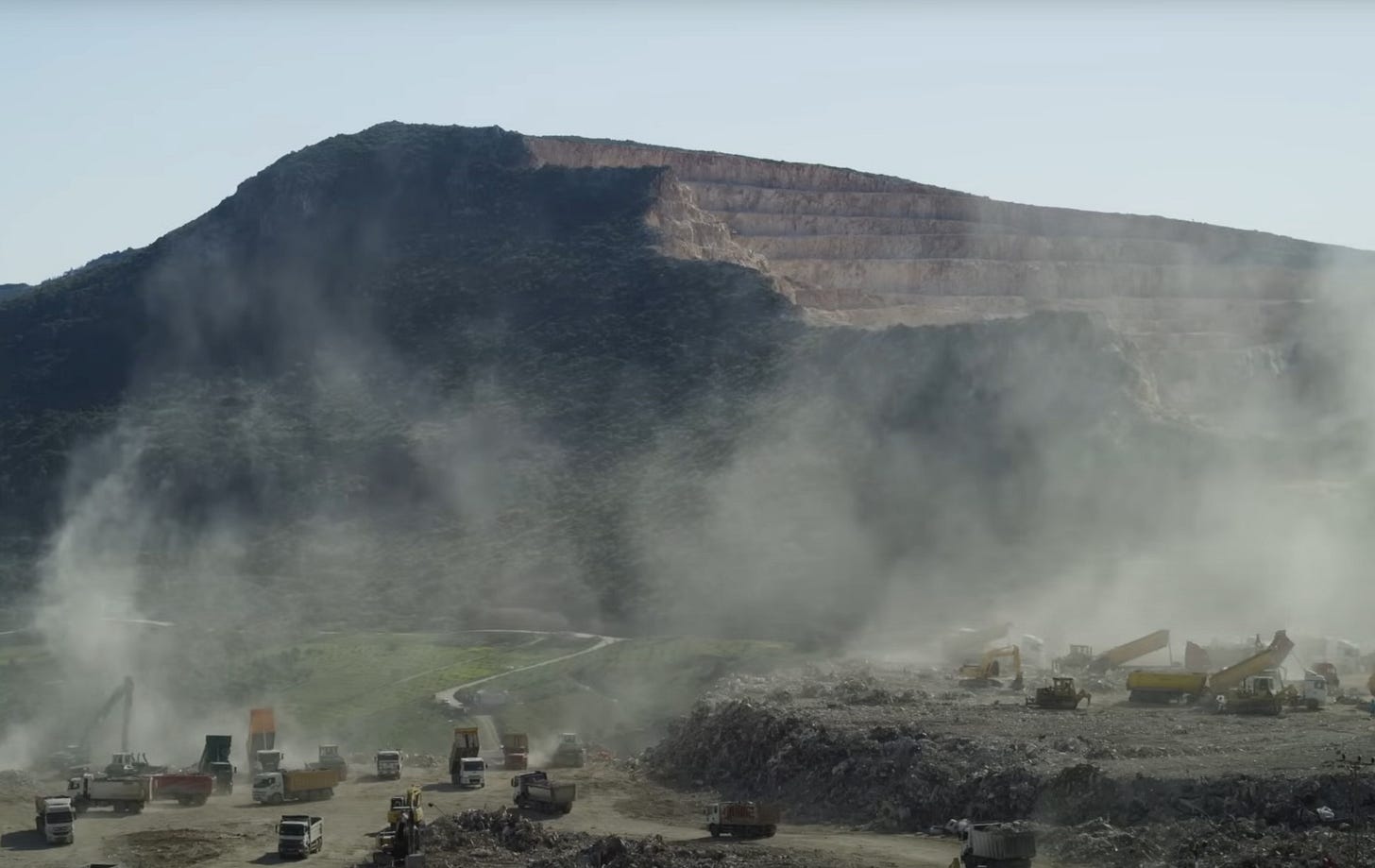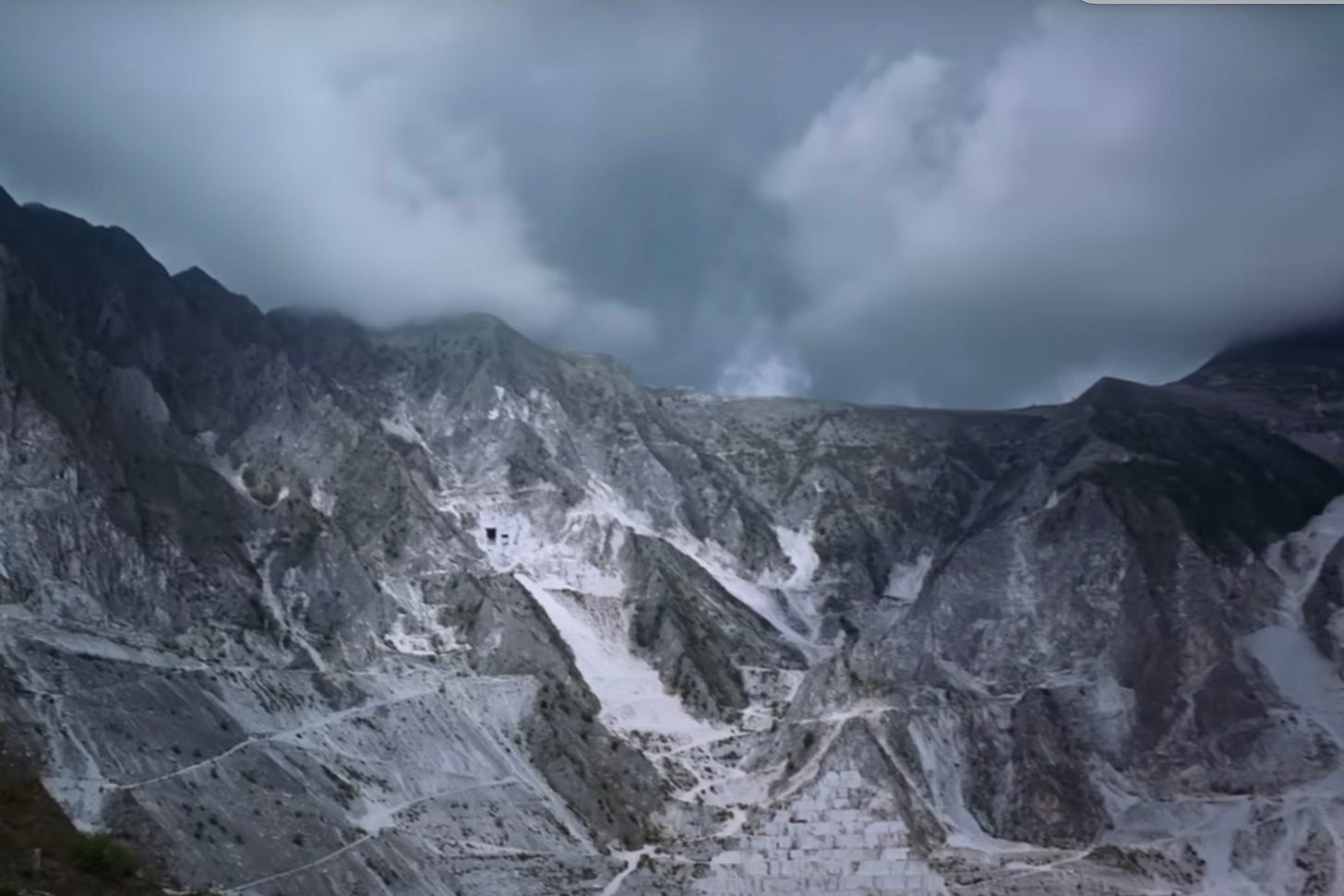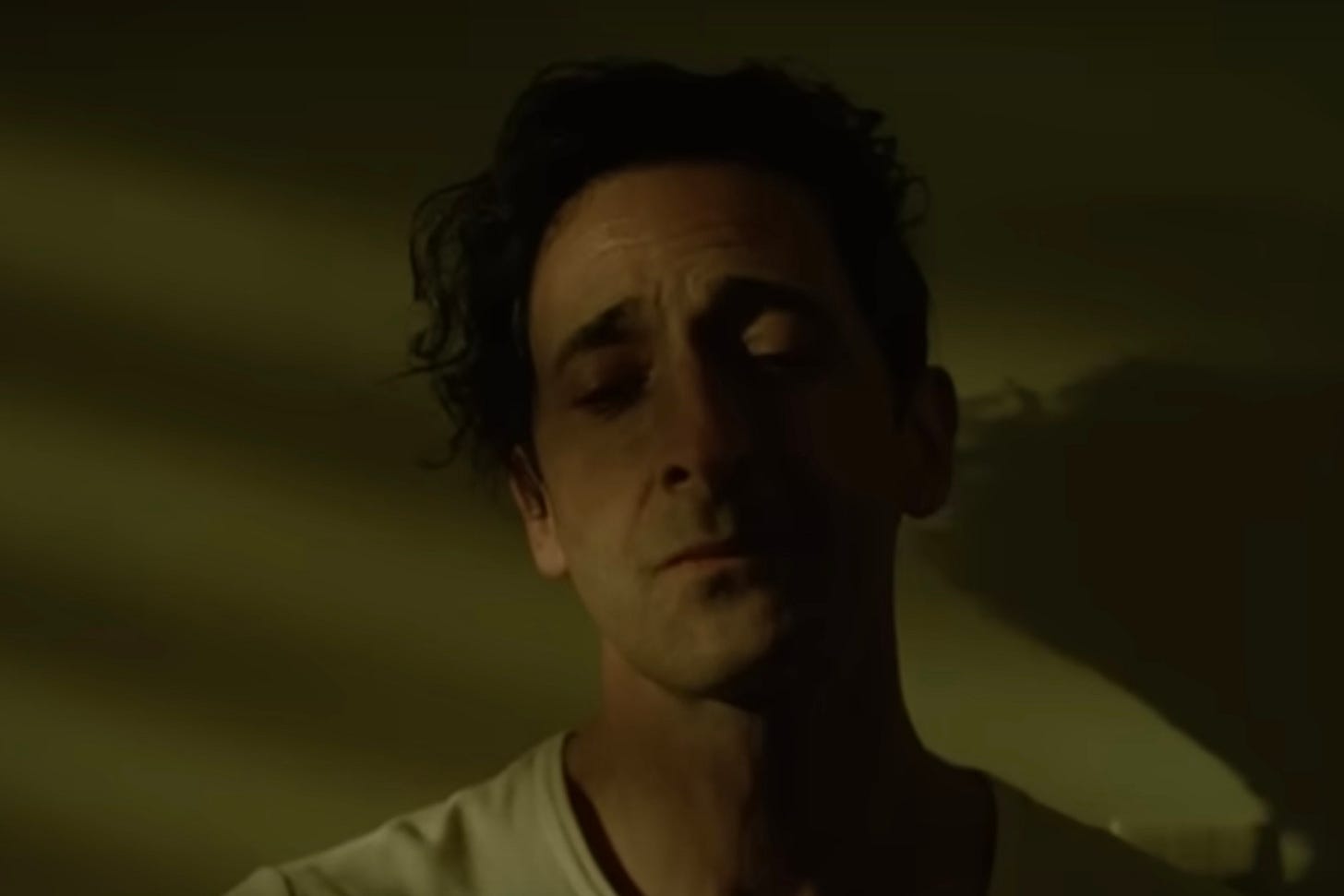FROM FUTILITY TO HUBRIS AND BACK AGAIN
Partial reviews of the films Architecton and The Brutalist
Towards the end of Victor Kossakovsky’s astonishing film Architecton there is a sequence set in Turkey after the devastating 2023 earthquake. A drone-mounted camera tracks across a view of bulldozers and hydraulic rams knocking down what remains of the ruined buildings. Trucks then take the rubble up to a towering landfill site and, in the other direction, trucks return empty in a circle of endless waste. At the top, bulldozers flatten the waste into a false land, diggers and trucks moving as in a choreographed dance. Then the camera pulls back. There, looming over the landfill site, is a quarry where raw materials are being extracted from the face of a mountain.
Watching this sequence took me straight back to a lecture, the story of which I recounted in my book Architecture Depends. In it, Peter Guthrie declaimed: ‘All architecture is but waste in transit!’ This statement is a shot to the heart of architectural pretensions of stability and eternity. Here it was starkly represented on screen in the joining of quarry to landfill with, somewhere out of shot, scenes of ruined architecture. Situated between these two poles, architecture feels very fragile, a passing moment in modernity’s project of violent extraction and intentional obsolescence.
There is a quarry in The Brutalist as well. Critics have raved over the cinematic and aural drama of the filming of this quarry, but it is pretty vanilla compared to the impact of Architecton’s ruthless wrenching out of the planet’s resources. The only things that engage with Architecton’s quarries are massive machines. These brutal devices lie at the end of a chain of man’s intentional separation from nature that started at the birth of the modern colonial project. “Only once we imagined the world as dead could we dedicate ourselves to making it so,” writes Ben Ehrenreich in the Desert Notebooks. In The Brutalist, the wall of Carrara marble has no such deathly associations. Quite the opposite. It is fondled by hand and caressed with a cheek, a luxurious softness that architectural genius will imbue with spiritual life. Man’s dominion over nature is expressed in The Brutalist as an act of creation, in Architecton as one of destruction. The latter is a much more realistic interpretation of architecture’s complicity in accelerating the ecological collapse that started with the rift from nature.
There is also a quarry in The Fountainhead, the film that is still referred to as a defining image of the architect. The architect Howard Roark is labouring in the quarry, having abandoned his practice because he was not prepared to compromise. This sacrifice is repeated in The Brutalist, with the Hungarian émigré architect László Tóth pictured toiling on a coal heap in Philadelphia. Other connections to The Fountainhead run through The Brutalist in a none too subtle manner. There are scenes in both of dominant, misogynist sex. In The Fountainhead, Roark rapes Dominique Francon, who will later become his wife. Ayn Rand, the author of the book on which the film is based, will later defend the scene as not one of sexual assault but as an expression of the ‘masculine strength’ that Dominique desired – but in any contemporary interpretation, it is rape. In The Brutalist, Tóth, thus far impotent because of his heroin addiction, finds his virility after he has rendered his wife helpless after an injection of said heroin. The implied association of priapic dominance with architectural will-to-power is deeply offensive in the two films.
Both films have caricatures of third-rate architects who stand in the way of the protagonist’s genius: ‘Everything that is ugly, cruel and stupid is your fault,’ shouts Tóth to the architect who has been appointed to try to deliver the impossible demands of Tóth’s ‘masterpiece. Both scenes have standard shots of the architect creating, a pencil or charcoal to hand.
And both are unintentionally funny. I once played The Fountainhead for my students at Sheffield, but I introduced a laugh machine that I activated at key moments of melodrama. It worked brilliantly, though after fifteen minutes I could switch the machine off because the tragicomedy was so apparent. In The Brutalist, some of the corniest lines were met with giggles by a significant portion of the opening night audience at the National Film Theatre in London – though it should be said that the other half, including some architects I spotted, applauded at the end of the film. The only time I really laughed was when Sarah whispered in my ear at the end of another completely uncalled-for rape scene: ‘well, that’s one metaphor for being fucked over by a client.’
These connections between The Fountainhead and The Brutalist are not accidental. They allow the director, Brady Corbet, to drive home the depiction of the architect as a tortured poet misunderstood by society but eventually able to overcome obstacles and produce works of eternal beauty. In dark times of terrible procurement processes, ignorant clients and butchering contractors, architects stubbornly resort to the myth of their creative genius, and so the two films The Fountainhead and The Brutalist give some solace. However, they also differ in their depiction of the architect’s turmoil in two important ways. Gary Cooper, who acts Howard Roark in The Fountainhead, plays the whole with imperious disdain, elevating himself above the crude mass of humanity by projecting his inner strength.
Adrian Brody, who plays Tóth in The Brutalist, is far more energised in his depiction. He draws on every possible twitch of the tortured poet in a performance that appears to have suckered the Oscar voters as well as Harrison Lee Van Buren, his client and patron in the film. When Tóth comes out with complete gibberish in a conversation with Van Buren – ‘Is there a better description of a cube than its construction?’ – van Buren doesn’t say (as he should): ‘That’s bullshit.’ He says: ‘That is so poetic!’ and then continues with, ‘I find our conversations intellectually stimulating,’ which will probably land the screenplay Oscar because those voters like to have their intelligence flattered.
The second clear difference between The Fountainhead and The Brutalist is in the underlying motivation of the two protagonists. Love it (i.e. the former UK home secretary Sajid Javid who read the courtroom scene to his future wife on their second date) or hate it (those left with any heart or empathy), Howard Roark’s libertarian individualism is clearly stated. Though one must wade through way too many words in the book, Ayn Rand’s position is unambivalently clear in its rejection of the state and of collectivism, and its disdain for nature. Tóth’s motivations in The Brutalist are much less clear, wrapped up as they are in the internalised archi-speak of an ‘egocentric scoundrel’ (his wife’s words, not mine.) It might be the trauma of the Holocaust has left Tóth’ rudderless, sometimes lashing out at feckless contractors, sometimes collapsing in his addiction, forming relationships and then breaking them. The architecture that emerges from this trauma is maybe inevitably wrapped up in his internal ordeals rather than an expression of broader concerns.
It is only right at the end, in an excruciating epilogue, that Tóth’s rationale is revealed. The scene is set in the 1980 Venice Biennale where Tóth has been given the honour of a retrospective exhibition. Let’s not dwell on the absurd stretch of this ‘brutalist’ architect appearing at the Biennale where post-modernism was launched onto the international stage. Let’s instead gasp at the banality of the final speech delivered by Tóth’s niece, Zsófia. The adoring crowd have come in past a set of posters of Tóth’s towering achievements, depicted in a series of artful drawings. (‘Hey, Mid-Journey, show me some pictures of a library in a mid-Western state designed by a Hungarian émigré trained at the Bauhaus…Yeah, not bad, but can you make them more intensely arty?...Great! Loving the charcoal…’).
One hundred ninety minutes into the film, we shouldn’t be surprised that Zsófia’s speech opens with a cliche: ‘His lifelong ambition was not only to define an epoch but to transcend all time.’ Timelessness is often cited as a defining feature of truly great architecture - buildings that stand over the tides of time, shrugging off changing cultures, tastes, climates and contexts. Time, that most ruthless of forces, is banished by the masterful hand of the architect, in contravention to the idea that ‘architecture is but waste in transit.’
But it was when the speech touches on the Holocaust that I really lost it. Tóth’s buildings are, Zsófia explains, expressions of the claustrophobia that he experienced at Buchenwald.
‘For this project, he re-imagined the camp’s claustrophobic interior cells with precisely the same dimensions as his own place of imprisonment…’
Enough! There is something shameless about Brady Corbet appropriating the horrors of the Holocaust for dramatic effect, and to do it in such a trite manner is still more offensive. But the Biennale audience looks on reverently, as we are meant to, and decides that participating in the Holocaust Industry is quite OK. This supposedly portentous speech – ending with yet another cliché: ‘It is the destination, not the journey.’ – gives way to a chirpy Italian disco tune. All that genocide is brushed aside so that, as Corbet’s partner and co-writer Mona Fastvold explains, the audience can leave with a ‘jolt of energy.’ That’s nice.
There is an architect in Architecton as well. This one is real. Michele De Lucchi, founding member of Memphis, the influential Milanese design practice. He is another tortured soul, but de Lucchi is not tormented by any thwarted greatness; his anguish is because of his helplessness in the face of a collapsing planet. All that is left for him to do is to build a circle of stones in his garden, a tiny gesture that he admits has ‘no practicality’, but nonetheless he imbues with meaning. He lays the last stone, the one that completes the circle. ‘The most beautiful one,’ he says. ‘Beautiful one,’ repeats his loyal labourer. ‘It was meant to be.’
And then we are abruptly taken away from the tenderness of this episode and back to another scene of destruction. Kossakovsky tracks the camera up the side of a mountain, which suddenly erupts into a torrent of rock. Large boulders are tossed like ships on a sea of writhing rocks. In one moment, the detritus flying off the face of a mountain becomes the image of the birth of the cosmos, with slivers of rock as emerging planets. In another scene, fragments of stone start to dance over a pounding soundtrack. In Kossakovsky’s hands, nature is not simply inert matter ripe for exploitation; it is alive and ready to wreak vengeance. Architecture is left exposed to these forces and the other catastrophes of modernity. He takes us over the bombed-out remains of Ukranian towns; to villages abandoned but for dogs, where nature has taken over; to a view over a generic cement city, which cuts into another shot of diggers. Only the ruins of Baalbek provide an anchor of stability, with de Lucchi reduced to tears by the riddle of their origin.
There is an epilogue in Architecton as well, one that flirts with collapsing into pure pathos, but is rescued through the despairing honesty of de Lucchi. He is sitting under a tree in his garden, the circle of stones in the foreground, talking with Kossakovsky.
‘Why do we make buildings for only 40 years?’ Kossakovsky asks. ‘Why do we build ugly buildings when we know how to build beautiful ones?’
De Lucchi sidesteps these questions, maybe because they set up false promises for how architects might redeem themselves.
‘Right now we are doing a building in concrete in Milan, and I’m ashamed of it,’ de Lucchi says in a voice dripping with sadness. ‘It’s just one of these skyscrapers, more or less tall. No meaning…I hate concrete. Concrete is arid. It doesn’t belong to nature.’
Later, when Kossakovsky asks if de Luchhi’s family will keep the garden circle forever, de Lucchi again diverts the inquiry.
‘We have limited chances of survival…we need to find a new paradigm.’
These almost final words of the film are followed by a camera tracking a machine that is endlessly printing out curvy concrete walls. There is no context, just the Sisyphean task of pushing another rock of purported progress up the hill, only for it to roll down destructively in the future. Architecton can be read as an essay on the futility of architecture in the face of the crises of modernity. But from the despair the film evokes, there is also a call for action, de Lucchi’s cry for a new paradigm. This so much a more honest message than the hubris of The Brutalist. Maybe architects need to watch The Brutalist and expel from their system what remains of their mythology of pure creation and then, along with Architecton’s de Lucchi, work outwards from their fragility.
Images are screenshots from the trailers of each film
The trailer for Architecton is here






Great Article - having read this one and Oliver Wainright's I can save 3 hours of ego bonkers cinema time for something lighter or more profound ( like the Italian film Vermiglio )
ta !